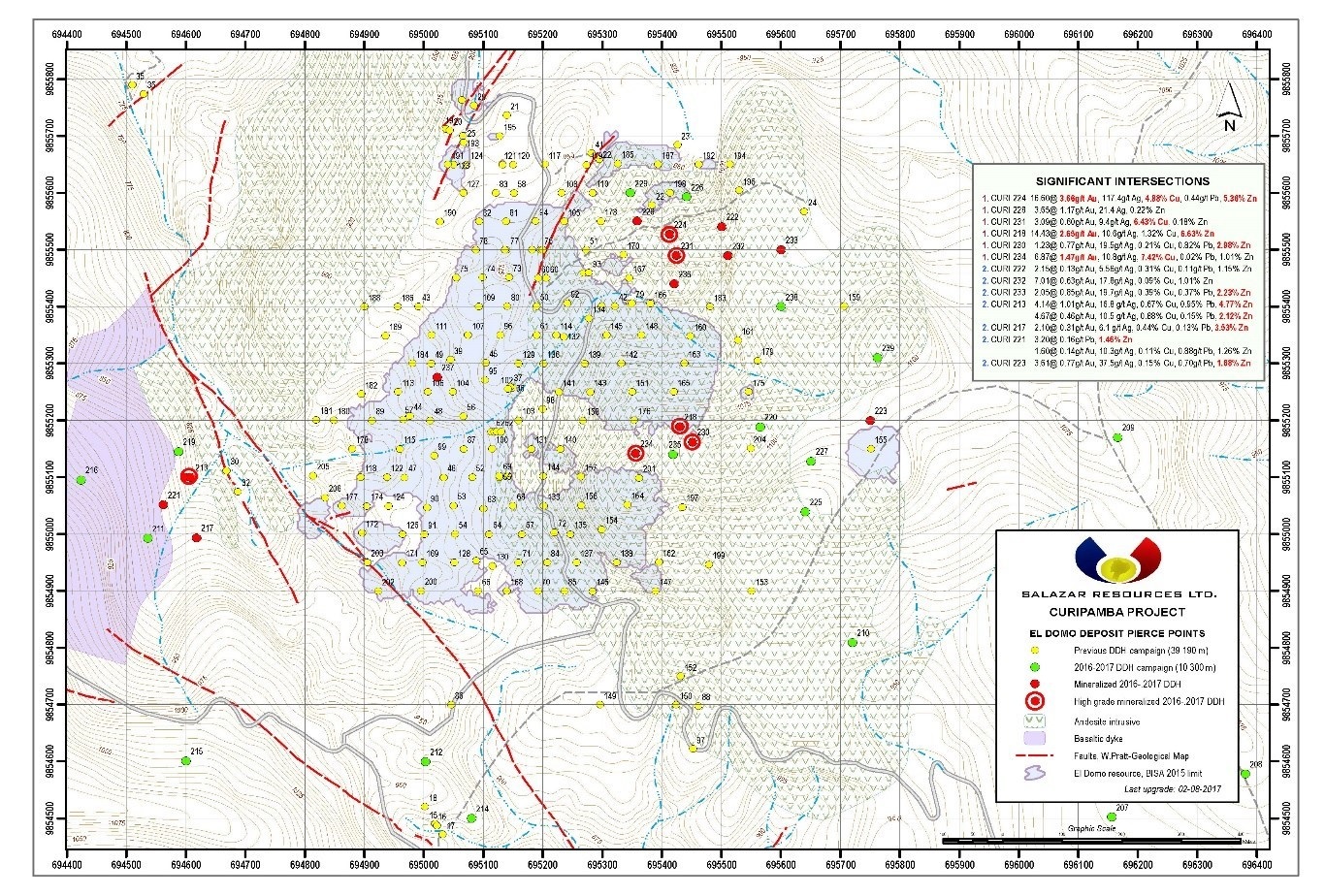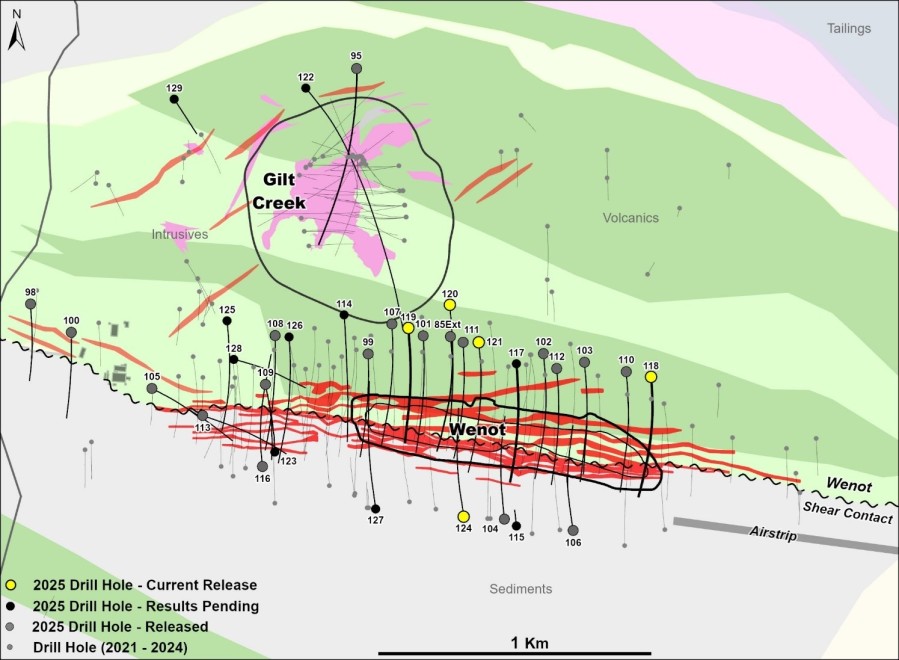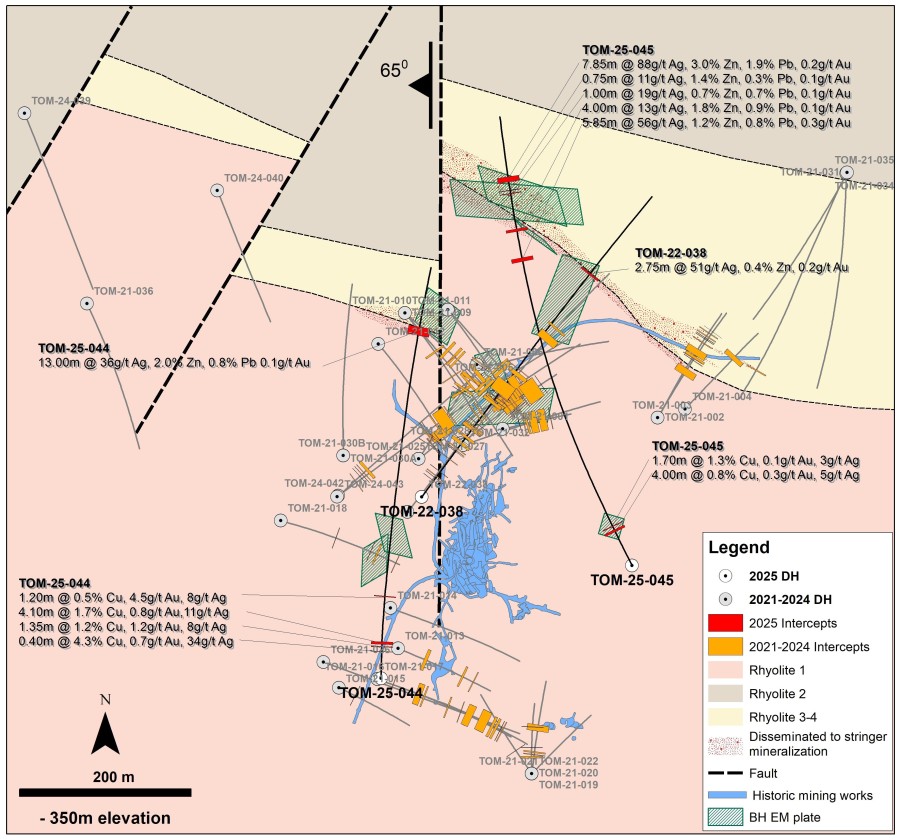VANCOUVER, Aug. 14, 2017 /CNW/ - Salazar Resources Limited (TSX.V: SRL; FRANKFURT: CCG.F) ("Salazar" or the "Company") is pleased to report results from an additional ten holes (2,791metres) of the phase V diamond drill, program that is in progress on the Company's 100-per-cent owned (21,500 ha) Curipamba volcanogenic massive sulphide (VMS) project in Ecuador. These holes represent new exploratory and development drilling and were not included in the latest El Domo resource estimate which was released on January 16th, 2015.
HIGHLIGHTS:
Hole CURI-234
- 6.87 metres (6.45 m true) averaging 1.47 g/t gold, 10.9 g/t silver, 7.42% copper, 1.01% zinc.
Hole CURI-231
- 3.09 metres (3.08 m true) averaging 0.60 g/t gold, 9.40 g/t silver, 6.43% copper, 0.18% zinc.
PROGRAM RESULTS:
The latest ten holes (2,791 metres) (Table 1) were drilled as part of the planned 40-hole (10,000 metres) drill program that is being completed with the purpose of expanding the El Domo volcanogenic massive sulphide ("VMS") deposit and exploring its margins, as well as testing geophysical anomalies and surface showings (Figure 1). It is anticipated that the drill program will be complete by the end of August of this year.
Figure 1. El Domo Deposit - Pierce Point Map
Hole CURI-231 intersected 3.09 metres (3.08 m true) averaging 0.60 g/t gold, 9.40 g/t silver, 6.43% copper & 0.18% zinc in a massive sulfide of pyrite and chalcopyrite. This intersection is located in the northeastern sector of the El Domo deposit, approximately 50 metres south from the CURI-224 which cut 16.60 metres (15.60 metres true width) of massive and semi-massive chalcopyrite-sphalerite-pyrite grading 3.66 g/t gold, 117.40 g/t silver, 4.88% copper, 5.36% zinc (News Release of May 15, 2017). This new intersection extends the previously interpreted mineralization trend identified by CURI-224 and CURI-198 an additional 50 metres to the south.
Hole CURI-234 was collared in the west-central sector of the El Domo deposit. It was drilled with a southerly azimuth to test a 100 meter gap that had no resource assigned to it, between the CURI-176 and CURI-201. It intersected 6.87 metres (6.45 m true) averaging 1.47 g/t gold, 10.9 g/t silver, 7.42% copper, 1.01% zinc in a massive and semi-massive sulfide of chalcopyrite, sphalerite and pyrite and 0.82 metres grading 0.74 g/t Au, 22.3 g/t Ag, 0.68% Cu and 1.93% Zn. These intersections are located approximately 50m north of CURI-201, drilled in March of 2011, which intersected 1.50 metres grading 0.977 g/t Au, 80.82 g/t Ag, 1.52% Cu and 2.5% Zn. Approximately 80 metres to the north-east, hole CURI-218 intersected 14.43 metres (13.07m true) averaging 2.65 g/t gold, 10.58 g/t silver, 1.32% copper, 6.63% zinc (News Release of March 23, 2017).
Fredy Salazar, President and CEO, commented: "We are moving forward with the intended exploration towards the east of El Domo.The mineralization intersected in CURI-231 and CURI-234 has shed new light on mineralization trends, and lithological and structural settings, on the eastern flankthus, helping us understand better the local and regional potential of this VMS body."
OTHER RESULTS:
Holes CURI-225 and CURI-227 were drilled from the same platform approximately 250 metres east of the El Domo deposit and approximately 70 metres east of the collar of hole CURI-218 (News Release of March 23, 2017). Both holes were drilled with a southerly azimuth to test the south-eastern sector of the El Domo mineralization and to further test the intercept in hole CURI-155 (3.61 metres grading 0.77 g/t gold, 37.54 g/t silver, 0.15% copper and 1.68% zinc (News Release of January 26, 2012). CURI-225 and 227 intersected the underlying dacitic unit which is weakly mineralized. However, this southeastern area still needs more exploration given that there are several structural features that could have acted as depositional and mineralization boundaries.
Hole CURI-226 was drilled close to the northern edge of El Domo. It was collared 70 metres east of hole CURI-198 (7.40 metres grading 2.498 g/t Au, 74.61 g/t Ag, 3.45 % Cu, and 5.07% Zn). CURI-226 did not encounter massive sulphide mineralization but it did intersect a short interval of the underlying dacite with a moderate hydrothermal breccia. This hole was aborted earlier than expected due to the mechanical problems.
Holes CURI-228 and CURI-229 were also drilled near the northern edge of the El Domo minealization. Both holes intersected the CURI-198 mineralization (see above) to the south-west and west, respectively. While holes CURI-228 and CURI-229 did not intersect massive sulfide mineralization, CURI-228 intersected two intervals of interest in the underlying mineralized dacitic unit: 3.65 metres grading 1.17 g/t Au and 21.42 g/t Ag; and 7.6 metres grading 1.07 g/t Au and 2.59 g/t Ag.
Hole CURI-230 was collared on the southwest sector of the El Domo mineralization. It was drilled with a southerly azimuth to test for extensions of the mineralization in CURI-218 to the south. This hole intersected the underlying mineralized dacitic unit approximately 80 metres higher than in the surrounding holes suggesting an upthrown block fault in this area. The intense fracturing and alteration of the rock caused the hole to collapse and the hole was abandoned without testing its original target depth. Even so, there are two mineralized intervals of interest in the dacitic unit found on this upthown block (Table 2). CURI-218 also intersected a similar upthrown block with mineralized dacite that could be correlated to the one found in the CURI-230.
Hole CURI-232 collared from the same platform than the CURI-231 and tested for an extension to the east of the mineralization in CURI-231. CURI-232 did not encounter massive sulphide mineralization but it did intersect a mineralized zone in the underlying dacitic unit (Table 2).
Hole CURI-233 was collared 150 metres east of CURI-232 and drilled easterly to explore the north-eastern limits of the El Domo mineralization. The hole intersected mineralization in the underlying mineralized dacitic unit (Table 2) at 160 metres from the El Domo resource. The presence of moderate to strong hydrothermal activity this far east from the main body suggests that the VMS mineralization could have been deposited and destroyed through an erosional period. This opens the possibility of finding VMS mineralization as far north-east as the CURI-24 (80 metres distance) which also intersected the dacitic unit with a moderate hydrothermal breccia on a large upthrown block. There is also a large un-drilled area to the south towards CURI-223, 225 and 227. Salazar will drill test this area as part of the current program.
TABLE 1
|
HOLE ID |
EAST |
NORTH |
ELEV (M) |
AZIMUTH |
DIP |
DEPTH (M) |
ACCUMULATED DEPTH |
|
CURI-225 |
695640.25 |
9855196.14 |
1081.00 |
180° |
-60 |
348.00 |
348.00 |
|
CURI-226 |
695432.20 |
9855592.93 |
978.16 |
90° |
-80 |
113.77 |
461.77 |
|
CURI-227 |
695640.25 |
9855196.14 |
1081.00 |
180° |
-75 |
369.70 |
831.47 |
|
CURI-228 |
695400.00 |
9855550.00 |
1050.00 |
270° |
-78 |
269.65 |
1101.12 |
|
CURI-229 |
695294.00 |
9855600.00 |
980.00 |
90° |
-70 |
251.70 |
1352.82 |
|
CURI-230 |
695451.00 |
9855222.00 |
1082.00 |
180° |
-75 |
242.80 |
1595.62 |
|
CURI-231 |
695443.00 |
9855490.00 |
1044.00 |
270° |
-85 |
278.80 |
1874.42 |
|
CURI-232 |
695443.00 |
9855490.00 |
1044.00 |
90° |
-75 |
317.75 |
2192.17 |
|
CURI-233 |
695592.00 |
9855493.00 |
1040.00 |
355° |
-90 |
263.70 |
2455.87 |
|
CURI-234 |
695356.00 |
9855239.00 |
1066.00 |
180° |
-70 |
335.70 |
2791.57 |
|
*PSAD_1956_UTM_Zone_17S |
TABLE 2
|
SIGNIFICANT INTERSECTIONS |
|
HOLE ID |
FROM |
TO |
WIDTH |
Au |
Ag |
Cu |
Pb |
Zn |
|
CURI-225 |
No significant mineralization encountered in this hole, located 250 m east from El Domo resource. |
|||||||
|
CURI-226 |
No significant mineralization encountered in this hole, located 30 m east of CURI-198. Hole aborted due to mechanical problems. |
|||||||
|
CURI-227 |
No significant mineralization encountered in this hole, located 250 m east of the El Domo deposit and 120 m southwest of CURI-155. |
|||||||
|
CURI-228 |
201.23 |
204.88 |
3.65 |
1.17 |
21.42 |
- |
- |
- |
|
211.78 |
219.38 |
7.60 |
1.07 |
2.59 |
- |
- |
- |
|
|
CURI-229 |
No significant mineralization encountered in this hole, located 100 m west from CURI-198. |
|||||||
|
CURI-230 |
213.29 |
214.15 |
0.86 |
- |
- |
0.21 |
- |
1.58 |
|
231.84 |
233.07 |
1.23 |
0.77 |
19.5 |
0.21 |
0.82 |
2.98 |
|
|
Located 40 m south of CURI-218. Hole abandoned due to poor ground conditions. |
||||||||
|
CURI-231 |
213.85 |
216.94 |
3.09 |
0.60 |
9.40 |
6.43 |
- |
0.18 |
|
225.74 |
233.66 |
7.92 |
0.31 |
3.71 |
- |
- |
1.19 |
|
|
CURI-232 |
231.25 |
238.26 |
7.01 |
0.63 |
17.90 |
- |
- |
1.01 |
|
CURI-233 |
236.15 |
238.2 |
2.05 |
0.85 |
19.70 |
0.39 |
0.37 |
2.23 |
|
CURI-234 |
282.85 |
289.72 |
6.87 |
1.47 |
10.90 |
7.42 |
- |
1.01 |
|
302.7 |
303.52 |
0.82 |
0.74 |
22.30 |
0.68 |
- |
1.93 |
|
Widths presented in Table 2 are downhole core lengths. Where possible, true width estimates are noted in the text.
A rigorous chain-of-custody and quality assurance/quality control program that included the insertion of certified standard control samples and blanks, and re-analysis of samples with high levels (overlimit) of gold, copper and zinc, was applied to the NQ-diameter, rock-sawn half-core samples. All samples were analyzed by Inspectorate Services Perú S.A.C. (Bureau Veritas), a certified ISO 17025 and ISO 9001:2000 laboratory.
As part of the program's sample quality assurance, twin quarter core samples were taken on all wells as described below. The samples were part of a Brecciated Dacite and gave the following results (Table 3):
TABLE 3
|
HOLE |
SAMPLE |
FROM |
TO |
LENGTH |
Au |
Ag |
Cu |
Pb |
Zn |
|
CURI-225 |
170432 |
329.7 |
330.67 |
0.97 |
0.103 |
2.7 |
20 |
133 |
403 |
|
170433 |
329.7 |
330.67 |
0.97 |
0.092 |
3.1 |
21 |
135 |
442 |
|
|
CURI-226 |
170442 |
107.85 |
109.36 |
1.51 |
0.18 |
0.8 |
20 |
26 |
68 |
|
170443 |
107.85 |
109.36 |
1.51 |
0.15 |
1.4 |
22 |
26 |
75 |
|
|
CURI-227 |
170484 |
323.1 |
324.25 |
1.15 |
<0.005 |
0.2 |
2 |
8 |
42 |
|
170485 |
323.1 |
324.25 |
1.15 |
<0.005 |
<0.2 |
3 |
9 |
38 |
|
|
CURI-228 |
170473 |
227.55 |
229.05 |
1.5 |
0.011 |
0.5 |
301 |
94 |
1809 |
|
170474 |
227.55 |
229.05 |
1.5 |
0.008 |
0.5 |
312 |
91 |
2255 |
|
|
CURI-229 |
170493 |
241.09 |
242.58 |
1.49 |
0.019 |
0.3 |
47 |
25 |
396 |
|
170494 |
241.09 |
242.58 |
1.49 |
0.019 |
0.3 |
53 |
26 |
392 |
|
|
CURI-230 |
170522 |
233.07 |
234.1 |
1.03 |
0.011 |
0.5 |
40 |
28 |
417 |
|
170523 |
233.07 |
234.1 |
1.03 |
<0.005 |
0.2 |
9 |
15 |
118 |
|
|
CURI-231 |
170511 |
248.45 |
249.56 |
1.11 |
0.027 |
0.4 |
87 |
439 |
1235 |
|
170512 |
248.45 |
249.56 |
1.11 |
0.025 |
0.4 |
83 |
422 |
1512 |
|
|
CURI-232 |
170539 |
290.5 |
292.2 |
1.7 |
0.296 |
2.8 |
292 |
178 |
8542 |
|
170541 |
290.5 |
292.2 |
1.7 |
0.202 |
2.4 |
201 |
291 |
3526 |
|
|
CURI-233 |
170547 |
248.9 |
250.4 |
1.5 |
0.013 |
<0.2 |
14 |
25 |
135 |
|
170548 |
248.9 |
250.4 |
1.5 |
0.01 |
<0.2 |
6 |
15 |
46 |
|
|
CURI-234 |
170591 |
324.95 |
326.48 |
1.53 |
0.012 |
<0.2 |
3 |
5 |
42 |
|
170592 |
324.95 |
326.48 |
1.53 |
0.011 |
<0.2 |
5 |
<5 |
48 |
The scientific and technical information contained in this news release has been reviewed and approved by Kieran Downes, Ph.D., P.Geo. a Qualified Person as defined by National Instrument 43-101.





